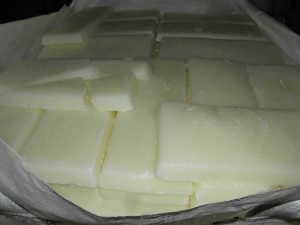Paraffin wax history

paraffin wax history
On a worldwide basis, the share of petroleum waxes related to the total o petroleum products is tiny. In 1975, for example, only 1.5 million tons of paraffin waxes were produced from a total output of 2,700 million tons of crude oil, thus amounting to only 0.06 %. Even if lower molecular weight paraffin products are included, the share — as compared to other petroleum products — remains insignificant. When, however, the greatly varied direct applications of solid and liquid paraffin in industry, and their utilization as raw materials in the petrochemical industry are considered, their importance becomes immediately obvious. For this reason, it appeared of interest to summarize — without claiming completeness —the basic facts and data on the manufacture, applications, Physico-chemical and chemical properties of these products in a monograph suited to both types of research and to industrial audiences. Nomenclature is also discussed.
Paraffinic hydrocarbons or paraffin wax are straight-chain or branched saturated organic compounds with the composition CnH2n+2. The term paraffin waxes are used for mixtures of various hydrocarbon groups, especially paraffin and cyclo-alkanes, that are solid at ambient temperature. Paraffin is present in large amounts in nature, but can also be produced synthetically and are formed as by-products in processing certain natural substances. Paraffins of low molecular weight are found in natural gas, paraffin of medium and high molecular weight in petroleum and ozokerite. On the industrial scale, paraffin can be manufactured from coal by the well-known Fischer—Tropsch synthesis. Paraffin are also obtained from the tar-like products obtained by the dry distillation of coal (mainly brown coal) and other organic materials (wood, lignite, bituminous shales, fish tallow etc.). In view of present trends.
Paraffin wax, solid at ambient temperature, are obtained from lubricating oil fractions having various average boiling points, from distillation residues resulting from the vacuum distillation of hydrocarbon crudes, and from the so-called tank waxes and pipeline waxes separated during the storage and transport of such crudes.
The nomenclature of paraffin waxes with different crystal structures will be discussed in detail in the following. However, we wish to mention in advance that the various types of paraffin waxes form essentially two groups. Microcrystalline paraffin waxes are mixtures which consist chiefly of saturated, normal C18-C30 hydrocarbons and smaller amounts of iso-alkanes and cycloalkanes. The molecular weight of the components varies between 250 and 450, their melting point between 40 and 60 °C. Their crystals are plate- or needle-shaped. Microcrystalline paraffin waxes contain, in addition to normal hydrocarbons, large amounts of iso-alkanes and naphthenic with long alkyl side-chains. The iso-alkanes form microcrystals and the major part of these waxes consist of C40-055 compounds. The melting point of microcrystalline paraffin waxes varies between 60 and 90 °C. The world production of paraffin wax increases from year to year. However, whereas this increase was around 60% between 1950 and 1960, the growth rate has decreased since 1960. This is mainly due to plastics (polyethylene, PVC, polystyrene, cellophane etc.) being increasingly used in packaging. It is of interest to note that while around 90% of the world production of paraffin wax in 1960-1961 consisted of microcrystalline paraffin wax, the present growth rate of microcrystalline paraffin wax production is substantially higher than that of microcrystalline paraffin wax. Sherwood’s data indicate that application of microcrystalline paraffin wax in the U.S.A. increased by 170% as early as in the period 1948-1958, whereas for microcrystalline wax the increase over the same period was only 10%. This shift is the result of the already mentioned expansion in the use of plastics in packaging. This same reason urged paraffin wax producers to improve the properties of both macros- and microcrystalline paraffin waxes by means of additives. A rich choice of such products is now available on the world market.microcrystalline paraffin wax. Sherwood’s data indicate that application of microcrystalline paraffin wax in the U.S.A. increased by 170% as early as in the period 1948-1958, whereas for microcrystalline wax the increase over the same period was only 10%. This shift is the result of the already mentioned expansion in the use of plastics in packaging. This same reason urged paraffin wax producers to improve the properties of both macros- and microcrystalline paraffin waxes by means of additives. A rich choice of such products is now available on the world market.

